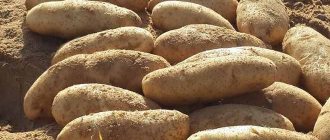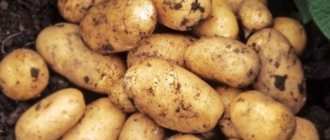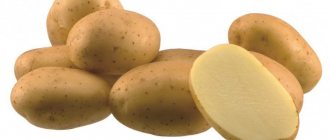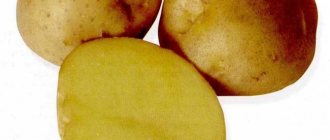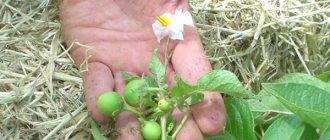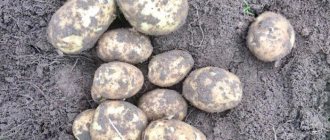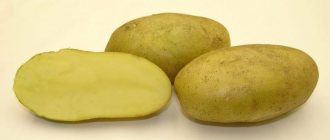Origin story
The Galaxy variety is considered a new product. The root crop was developed by Irish breeders. Initially, scientists set themselves the task of obtaining an early-ripening variety that was practically not affected by late blight. Additionally, special attention was paid to taste, as well as the possibility of long-term storage of the crop during the winter period. The crop passed varietal tests and was distributed throughout the Russian Federation.
Reviews from gardeners
The “Galaxy” variety is very easy for gardeners to identify against the background of potato tubers of other varieties due to the presence of very characteristic stains around the eyes. When purchasing seed material recently, gardeners very often face the problem that the most common ones on sale are low-quality or disease-affected tubers, which begin to rot at the point of attachment of the stolon. A very effective way to prepare tubers for planting in this case, in addition to germination, is preventive treatment. Reviews about the variety are definitely more positive, which indicates the prospects for cultivation in our country.
Description and characteristics
In terms of ripening time, the Galaxy variety is considered mid-early. The crop is high-yielding and is rarely affected by nematodes and late blight. The tubers have good taste, excellent presentation, and are resistant to mechanical damage. According to its intended purpose, the Galaxy variety is considered a table variety. The advantage of Irish potatoes is their stable yield every season. Detailed characteristics of the variety are given in the table.
| Growing season | maximum 90 days |
| Starch content in pulp | from 16 to 18% |
| Tuber weight | about 90 g |
| Number of potatoes in one bush | from 12 to 14 pieces |
| Productivity per 1 ha | from 250 to 300 quintals |
| Percentage of safety in winter in the cellar | about 95% |
| Tuber skin color | white |
| Flesh color | white with a yellowish tint |
| Immunity to disease | nematode, late blight, cancer, average resistance to scab |
| Best Growing Areas | the Galaxy variety is adapted to the climatic conditions of all regions of the Russian Federation |
| Features of the variety | Standard agricultural technology is suitable for cultivation; the above-ground part does not dry out for a long time |
| Features of tubers | the pulp does not darken quickly after peeling, excellent taste |
| Purpose | tubers are used for any dishes, starch, but are best in demand when making purees |
Bushes of the Galaxy variety grow tall. The tops are powerful and do not lie on the ground. Peduncles of medium size. The corolla is bright red with a purple tint. Potato leaves are large and rich green in color. The root shape is oval. The eyes are small, painted scarlet around the perimeter.
Advantages and disadvantages
The variety has a number of advantages. Among the main ones it is worth noting:
- excellent immunity, which protects, in particular, from diseases such as late blight;
- excellent presentation, making potatoes easy to sell on the market;
- good taste;
- The pulp has no tendency to darken when damaged or heat treated.
- excellent yield.
There are no shortcomings as such. The only downside is that the variety is not very protected from scab. Also, by the time of harvesting, the tops do not have time to dry, which makes digging up root crops much more difficult.
Landing
Attention!
Learn more about planting potatoes. As for the Galaxy variety specifically, the crop grows best in the place of perennial and annual grasses, legumes, and grains. In sandy soil conditions, potatoes can be planted after lupine.
Attention! For Galaxy potatoes, the thickness of the arable soil layer must be maintained within 27–30 cm.
In the spring, before planting, fertilizers are applied during plowing to replenish the soil with nutrients. The optimal time for planting tubers is early May. Plant potatoes in rows. The row spacing is at least 60 cm. The distance between tubers is 35 cm. Planting potatoes are immersed to a depth of 10 cm.
About a month before planting, the tubers are taken to a bright, damp room. Here they will germinate until they sprout. It is advisable to sort through the potatoes to identify spoiled tubers.
Since autumn, many pests have hid in the ground for the winter. To prevent them from destroying the potatoes immediately after planting, the tubers are treated with fungicides.
Attention! Detailed information about processing potatoes before planting.
Characteristics of the Galaxy potato variety
Galaxy culture is resistant to cracking. Easy to transport. Not afraid of long distances. Storage time is 9 months if favorable conditions are created. The Galaxy variety has excellent drought and frost resistance.
Productivity
Potato Galaxy is a high-yielding variety. On average they harvest 27 t/ha. The bush produces about 13 tubers.
Important! If you plant the seed deeply, the crop will grow small because there will not be enough nutrients.
Advantages and disadvantages
Compared to other potato varieties, Galaxy is valued for its large number of advantages. The culture requires a minimum of attention and pleases with a stable harvest.
A small number of eyes form on the tubers
pros
- resistance to fungal diseases;
- high commercial qualities;
- the flesh of the Galaxy does not darken;
- taste;
- stable yield under unfavorable conditions.
Minuses
- resistance to scab is average;
- By the time of harvesting, the tops do not dry completely, which makes harvesting the fruits difficult.
Important! If groundwater passes at a depth of 1.5 m, then excess moisture can interfere with the development of tubers.
Care
The Galaxy variety will bring a harvest even to a lazy vegetable grower, but with good care it will show the best results. The culture loves loose soil and a complete absence of weeds. Basic care for the variety requires compliance with the following rules:
- Fertilizer for feeding the Galaxy variety should be in an easily digestible form. The plant absorbs nutrients well from all types of compost, a slurry mixture of peat and manure.
- In case of freezing of the above-ground part by spring return frosts, the bushes are fed with mineral fertilizer containing nitrogen.
- After 100% of the seedlings appear, the row spacing is constantly weeded and the soil is loosened. The procedure is carried out until buds appear on the tops.
- When the stems reach a height of 20 cm, the Galaxy potatoes are hilled up. Use a hoe or walk-behind tractor to rake up the soil on both sides of the row.
- The variety loves moist soil. During watering, bring the soil to a moisture content of at least 70% - maximum 85%.
When growing the Galaxy variety, the condition of the tops is monitored. If the Colorado potato beetle begins to chew on the leaves, the plantation is sprayed with pesticides.
The video shows the process of growing potatoes:
Hilling and feeding
The Galaxy variety, like any other potato, cannot do without hilling. The process stimulates the growth of the bush by removing weeds and improving oxygen access to the roots. Tubers set and grow inside the earthen tubercles. During the season, two mandatory hillings are carried out and a third, if necessary. The first procedure is performed after the tops have grown to a height of about 15 cm. The second hilling of Galaxy potato bushes is done 12 days after the first procedure.
Advice! The need for a third hilling arises when earth mounds are washed away by rain or watering and potato roots appear on the surface.
The Galaxy variety responds well to fertilizing. The first fertilizer is poured into the holes when planting the tubers.
Attention! Read more about how to fertilize potatoes when planting in a hole.
During the growing season, Galaxy potatoes are fed three times at the root:
- At the initial stage of tops growth. The Galaxy variety needs feeding if the bushes grow slowly, the stems are thin and weak, and the leaf blade is pale in color. Usually two recipes are used: 10 liters of water/1 tbsp. l. urea or 10 liters of water/0.5 liters of mullein slurry. The prepared solution in a volume of 0.5 liters is poured under the bush.
- During the formation of buds. Fertilizing potatoes of the Galaxy variety is needed to accelerate the appearance of flower stalks. The solution is prepared from 10 liters of water, 1 tbsp. l. potassium and 1 tbsp. l. ash. If there is no potassium sulfate, add 1 cup of ash to the same amount of water. 0.5 liters of the prepared solution is poured under each bush.
- During vigorous flowering. The third feeding of the Galaxy variety promotes tuber setting. The solution is prepared from 10 liters of water, 2 tbsp. l. superphosphate and 1 cup mullein slurry. Under each bush, 0.5 liters of the prepared solution is similarly poured.
Fertilizing under the root of the Galaxy potato is carried out after watering or precipitation, when the ground is still wet. The method is suitable for owners of a small plot. If the garden is large, it is difficult to water each potato bush. For application, dry mixtures are used, applying them by scattering under the bushes.
The composition for three dressings per 1 bush is as follows:
- 0.5 tsp. urea/200 g dry manure;
- 1 tbsp. l. ash/0.5 tsp. potassium;
- 1 tsp. superphosphate.
After applying dry fertilizers, the potato plantation is watered.
Pros and cons of the variety
Why is this potato variety so good? The list is long, but the main points need to be listed separately:
- Not fussy to grow. Potatoes "Gala" grow well in almost any climatic zone of the country. Its ripening time allows you to obtain a very large number of tubers, even at low temperatures during the potato growing season.
- Virus resistance. Does not require special chemical treatment.
- Maturation period. The first tubers can be dug 65 days after they were planted. You can actually get a full harvest in just two months.
- High yield. From a hundred tubers, potatoes bring a truly impressive result - no less than 400 kg of yield.
- High quality taste, confirmed by world tasters.
"Gala" was grown specifically for a specific soil and climate, but adapts to any conditions. It does not lose its productivity, even if it was placed in sandy loam soil with a low amount of humus. This variety is highly praised by summer residents and farmers because of its high yields and unpretentiousness.
Positive reviews indicate that potatoes have no practical disadvantages. Of these, only two can be noted:
- Do not delay collecting tubers. The quality of potatoes decreases.
- Susceptibility to late blight, which appears when there is excess moisture and at low temperatures. Unfortunately, such conditions are common in many areas of our country.
Separately, it is worth noting the healing abilities of the Gala potato. In folk medicine, juice is used for:
- heart and kidney diseases;
- stomach ulcers and gastritis;
- hypertension;
- restoration of metabolism;
- burns and skin ailments;
- poisoning with plant poisons.
This variety is highly valued for its high potassium content: 500 g per 100 g of tuber, its composition is close to bread, and its vitamins are similar to greens.
Contains all amino acids necessary for the human body.
Diseases and pests
Potato diseases occur as a result of bacterial growth. Often the person himself is to blame for violating the cultivation and care technology. Most diseases are difficult, almost impossible, to cure.
Attention! More detailed information about existing potato diseases and control methods.
Scab is considered a common disease. Some gardeners ignore this disease, considering it less dangerous. This is fundamentally wrong. Scab can destroy a lot of crops.
Attention! About methods of combating scab.
Among the pests that like to feast on potatoes are the Colorado potato beetle, wireworm, and nematode. The first problem is easier to identify. When the Colorado potato beetle appears on the tops or yellow larvae, the potato plantation is sprayed with chemicals. Nematodes and wireworms eat the tubers. The appearance of the pest can be recognized by the withering bushes. The development of parasites can be prevented by frequent mechanical tillage of the soil. When the first symptoms appear, chemicals are used.
Harvesting
Three months after planting, the Galaxy potato tubers will be ready for harvest. However, the exact date varies for each region due to weather conditions. Potato tubers are dug up using a shovel or mechanical means, such as a walk-behind tractor. For winter storage, use an equipped vegetable storage facility with good ventilation, humidity of about 85% and air temperature of 3°C.

